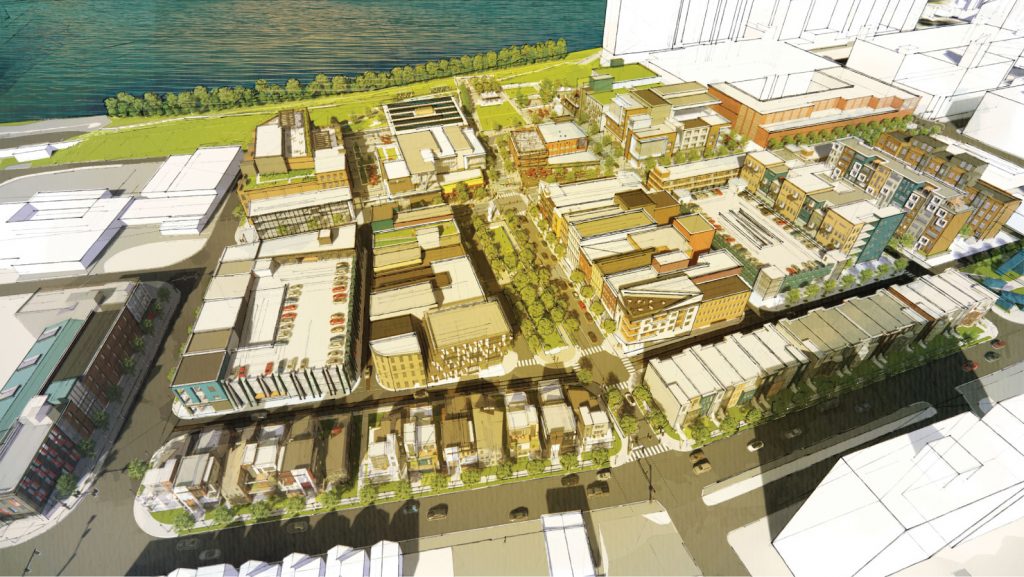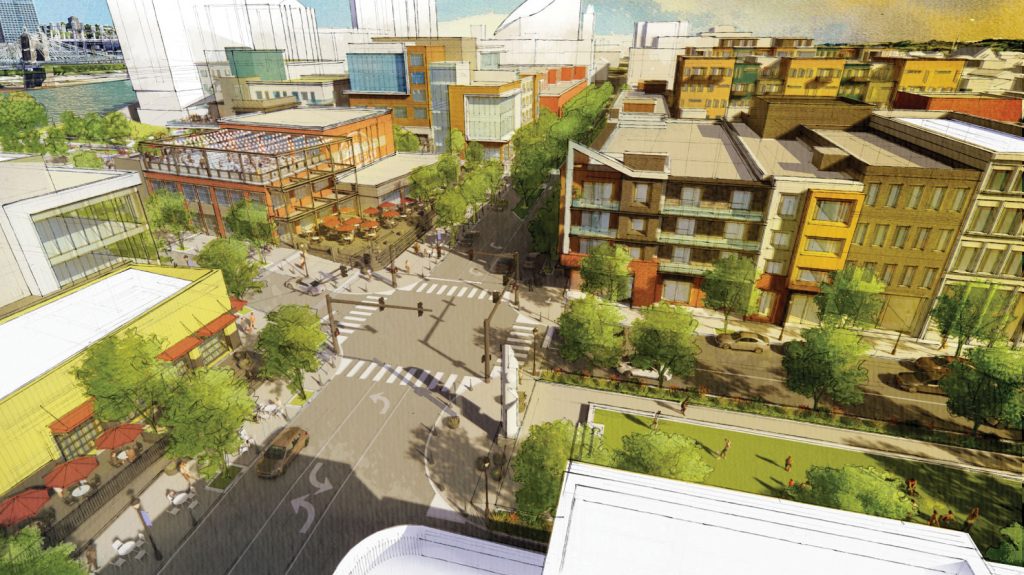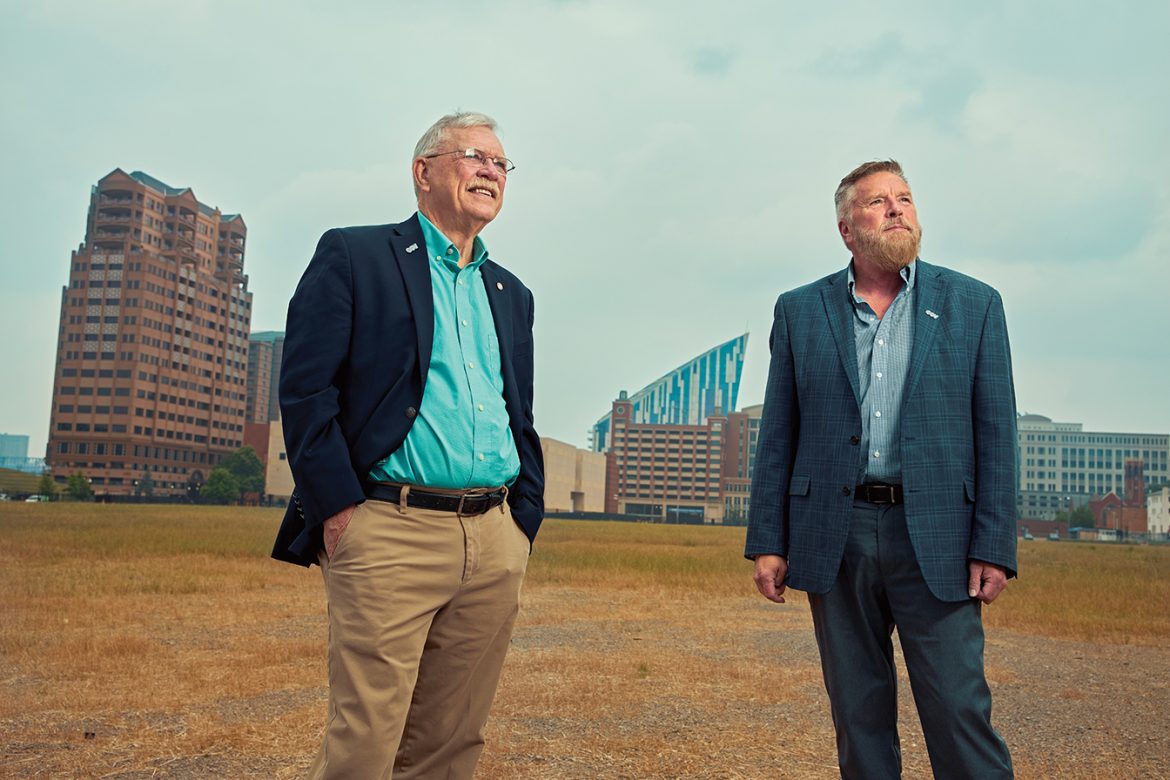Seven years ago, the Internal Revenue Service dropped a bombshell announcement on Northern Kentucky and the entire region: It planned to close its sprawling tax return processing center in Covington. The IRS facility had been a steady provider of jobs in Northern Kentucky’s largest city since opening in 1967, and the closure would mean the loss of more than 1,800 positions—nearly 10 percent of Covington’s workforce.
Officials at the nation’s tax agency explained that times had changed. More people are filing their returns electronically, and the agency no longer needs many sites like the Covington center, where paper returns were processed. While the closure meant the loss of full- and part-time jobs and about $1.5 million in payroll tax revenue for Covington, city officials received a three-year notice of the move and almost immediately began eyeing the downtown site for possible development.
When the closure plan was announced, then-City Manager Larry Klein first expressed sympathy for those who would lose jobs and for surrounding businesses that would lose customers. But he went on to say, “With every challenge there is an opportunity. One door closes and another opens. This announcement could open up 23 acres of prime riverfront property.”
Flash forward to today, and Covington officials have purchased the property, demolished the massive building, prepped the site for development, and begun marketing it to developers. Before they did all that, city leaders came up with a vision for what they want. It’s a rare opportunity to reimagine more than 20 acres in the urban core bordering the region’s signature natural landmark, the Ohio River. Covington leaders wanted to be deliberate in their decision-making, rather than leave the plans in the hands of a few private developers.
“Generations from now, when people talk about Covington, this complex will dominate their impression,” Mayor Joe Meyer said when demolition began to clear the way for the new development. “We’ve been working on an array of exciting initiatives over the last few years, but nothing compares to this project in magnitude and long-term impact.”
“We’re basically rebuilding a neighborhood,” says Tom West, the city’s economic development director and point person for the project, which is now officially called the Covington Central Riverfront Development. With a background in urban planning (master’s degree from the University of Cincinnati) rather than finance or business, his perspective and experience are evident in the game plan for the project.
[Read about another signature development coming to Covington’s riverfront, OneNKY Center, here.]

For more than 50 years, the IRS facility and its acres of surrounding parking lots had essentially acted as a barrier to the river and to easy connections among some of Covington’s neighborhoods. The city of 40,000 claims 19 different neighborhoods, including, in the vicinity of the IRS site, Mutter Gottes (named for Mutter Gottes, or Mother of God, Church); Old Town; MainStrasse; and the Central Business District. Before proceeding with redevelopment, the city assembled a team of consultants, some of whom sought the public’s opinions through surveys and open feedback sessions.
In 2018, the city hired Atlanta-based architecture and design firm Cooper Carry to draft a master plan that would serve as a conceptual starting point to guide what will be years of detailed planning and construction. Assisted by Atlanta-based firms Noell Consulting and DaVinci Development and Cincinnati- based architecture and engineering firm Woolpert, Cooper Carry embarked on a 10-month analysis into how the site should be developed. The process included the public’s engagement through open houses, “civic dinners,” meetings, and surveys. “What the community told the consultants is that they want to weave the property back into the urban fabric,” West says.
To that end, the plan calls for streets that were cut off by the center’s sprawling footprint to be restored (Third, Russell, and Washington). Great old neighborhoods also have alleyways, and the plan calls for those to built. “Alleys are part of our urban fabric,” says West. “We use them for bicycles, pedestrians, deliveries. We’ve got a couple of businesses whose address is actually the intersection of two alleys. So they serve a very important function.”
The planners saw that a reconnection to the river really couldn’t happen with the 80-foot high Northern Kentucky riverfront floodwall blocking views and access, so they’ve envisioned raising the platform of the development area by building on top of parking garages, similar to how The Banks across the river was raised out of the flood zone through the construction of parking garages that then served as podiums for development.
The plan also anticipates new public spaces, including a park atop the floodwall and a public plaza that could be used for festivals and other events. “Folks expressed that they would like to have some kind of public space for gatherings,” West says. “If we do large-scale gatherings in Covington, we don’t have a Fountain Square type of area. We have to shut down streets.”
One of the current renderings shows a large park-like town center space in the middle of the development, with a plaza and overlook jutting out over the floodwall for views of the river and Cincinnati’s downtown skyline. The master plan emphasizes walkability and is pedestrian-focused rather than car-centric. Planners see the scale of the development as blending in with the surrounding neighborhoods, where 150-year-old homes share the streets with small businesses.
But they don’t want to attempt to mimic the style of the surrounding built environment. “We don’t want to see fake historic architecture,” says West. “We’re not building Main Street at Disney World. We want 21st Century architecture at a human scale, with walkability—an environment that’s built for people and not necessarily cars or people in tall elevators.”
A virtual “fly-through” rendering of the plan shows a variety of modern architectural designs of three- and four-story buildings, with lots of use of glass, beams, and brick, a look that West says drew some comments from residents who were hoping to see architecture that was similar in style to what was built nearby in the 19th Century. But West explains that when downtown Covington was built, roughly 125 to 175 years ago, it was built with what was then considered a contemporary style. Mimicking that makes the historic architecture seem somehow less, he says.
“To me, and I think to a lot of other folks who really value historic preservation, when you try to reproduce it and you put something fake next to something that’s real, you devalue the real,” he says. West hopes the district will one day be considered historic in its own right, something he acknowledges he won’t be around to witness. “My idea of success is if someone goes down and stands at the corner of Third and Russell 100 years from now and looks around and says, What an amazing historic district. To me, that would be the ultimate sign of success.”
In terms of jobs, Covington officials see this opportunity as being similar to the original IRS project in the 1960s, when the government created well over 1,000 jobs there. The planning model forecasts that, in its initial stages, the central riverfront development will create 1,159 jobs and 1,651 temporary construction jobs. It’s estimated that the new “permanent” jobs alone would bring in more than $1.7 million in payroll tax revenue to the city. Further development in later stages would create more jobs and revenue, more than making up for the loss of IRS employment.
It will be a “mixed-use” development with housing, office space, and retail establishments. There will be space for skyline-worthy corporate office buildings as well as locally owned small businesses. “Because we’re elevating the site, they’re going to have spectacular views,” West says. “They’re going to become iconic buildings on the Covington skyline, where a corporation may want to put their headquarters name there. We also want to make sure that small local developers and smaller creative companies, a shop of 10 or 15 people, could also find space in this neighborhood. It’s that variety that gives it authenticity.”
When it comes to retail, the city has a guiding principle. Some cities have mottos, and others have mission statements. Covington has a manifesto that was formally approved by its city commission in 2022: “All character, no chains.”
Corporate-owned retail will not be sought or incentivized to locate there, but local coffee shops, bars, restaurants, and merchants will, West says. “We focus our small-business program and our other incentives on locally owned, locally operated types of businesses,” he says. “That’s what’s going to make this place special.”

A key part of Covington’s strategy for making the IRS site a neighborhood of diverse uses is to seek multiple developers rather than to turn the entire project over to a single company. In May, the city took an initial step in that direction by seeking private developers for three of the site’s parcels and a broker to market a fourth. The request for proposals was essentially a test to determine interest and gather ideas, as the four lots range in size from less than a half-acre to a little more than two acres.
“We are looking to set the tone for the quality and style of the new neighborhood,” says West. “We want multiple owners, different architects, different materials, and new ideas and tenants.”
If any of the proposals are accepted, ground could be broken on those parcels by the end of the year, he says.
The city, working with architectural firm KZF Design, is preparing the “horizontal infrastructure” to get that ready for development: the streets, alleys, sidewalks, utilities, parking garages, and public spaces. “If you’re a developer, you’re going to have utilities brought basically to your door,” West says. “And you’re going to have incredible public spaces developed throughout the project. Streets, sidewalks, alleys will all be built for you by the city. That’s going to give us that consistency throughout the neighborhood.”
The cost to build the public infrastructure, including the parking garage, is estimated to be about $70 million. Covington bought the site from the federal government in 2020 for $20.3 million. That was a handsome return on investment for the U.S. General Services Administration, which bought the site for the IRS in 1962 for all of $1.
Covington’s agreement then to essentially gift the site to the federal government was the key to the city landing the IRS project, which was highly sought after by several other cities, including Cincinnati. When the IRS made its decision, the front-page headline of The Kentucky Post and Times Star on January 24, 1962 read, “City Jubilant Over IRS Victory.”
To create the site, Covington officials at the time assembled and purchased 161 different properties, then demolished homes and businesses, tore up roads, and rerouted water and sewer lines to serve the project. The IRS site, at its peak, provided 4,000 jobs, many of them part-time during tax season.
Turning ground on a parcel or two this year be a quick win, but the site will take years to be fully redeveloped. Much will depend on the overall economic landscape, and rising interest rates, supply chain backups, and labor shortages are generally slowing construction projects these days.
West says city officials want to be choosy in their approach and wait for development proposals that match the project’s vision, which was based partly on community feedback. “We can afford to be a little more patient maybe than the private sector can, and a little more picky,” he says.
For comparison, The Banks riverfront development site between the Reds and Bengals stadiums, roughly the same acreage, is only now nearing completion 15 years after its official groundbreaking. Across the Licking River from Covington in Newport, the Ovation project, a 25-acre riverfront site owned by a single developer, Corporex Cos., is now rising out of the ground after 15 years of planning and delays.
“I’ve been preaching patience to my elected officials,” says West. “I’m not referring to this as a development or a project. It is a multitude of projects. And, like most neighborhoods, it needs to evolve over time.”
Reactions to the plan among others in the business community has been positive. “This site is gigantically important for the economic development of the metro region,” says Lee Crume, CEO of the economic development agency BE-NKY. Crume, who lives in Covington, calls the goal of reconnecting the city and “putting the city back together again” important for the community.
Richard Dickmann, who owns barbecue and bourbon restaurant Smoke Justis a few blocks from the site, also notes the objective of reconnecting Covington neighborhoods. “The most important aspect is the connectivity of the business districts closest to the river,” he says. “A huge gap will be filled in the street grid to provide a much greater pedestrian-friendly experience for locals and visitors alike.”
Tom Banta, chief real estate officer for Corporex, the company that pioneered Covington’s riverfront development beginning in the 1990s, says the city’s plan will contribute to the region’s urban revitalization. “We congratulate the city of Covington on its efforts to reclaim and redevelop the former IRS site into a new and exciting contemporary neighborhood,” he says.
The development may also help in the region’s quest to attract and keep talented workers. “That’s how you win in today’s economy,” says David McAleese, research director for BE-NKY. “Having something like this as an option adds to the ability of our region to attract talent.”
“The importance of this half-a-billion dollar investment can’t be overstated,” says Pat Frew, executive director of the Covington Business Council. “In my lifetime, it’s been the biggest economic development effort to hit the city, and it probably will be for generations to come.”


